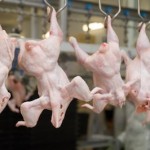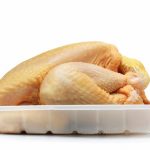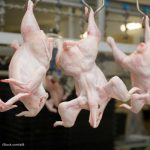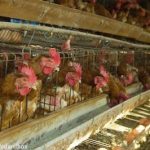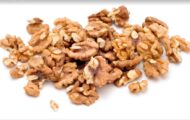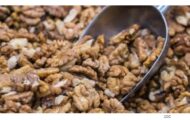The Government Accountability Office released an analysis yesterday of the HACCP-based Inspection Models Project (HIMP) in poultry slaughter. The USDA is using that project to justify a proposal to private poultry inspection in some plants in this country. The proposed rule, called "Modernization of Poultry Inspection" published in January 2012, would use untrained company employees to replace most FSIS inspectors on the poultry slaughter lines. The rule would also increase chicken plant line speeds to increase to 175 birds-per-minute from 140, raising questions about worker safety and food safety. Senator Kirsten Gillibrand (D-NY) requested the GAO report. The report evaluated USDA's examination of 20 young chicken plants and 5 young turkey plants for the HIMP proposal and found … [Read more...]
Don’t Wash That Bird! Animation Shows Spread of Contamination
Remember when we told you last year to not wash turkeys and chickens before you cook them? Washing just spreads pathogenic bacteria around the kitchen. Now there's visual proof of what happens when raw meat is rinsed under the kitchen faucet. Drexel University has launched a new campaign called "Don't Wash Your Chicken" to urge consumers to drop the habit. They have released a video filmed with what they call "germ vision" that shows how bacteria spread onto adjacent surfaces (and you) when a chicken is rinsed under running water. Oddly, the film focuses on "minority populations", because those groups seem to be more likely to wash raw poultry before cooking. When you wash raw meat under running water, the bacteria "aerosolizes", or becomes airborne, and it can end up three feet … [Read more...]
Chilean Chicken Recall for Dioxin Expands
The recall of chicken for dioxin contamination that was imported from Chile has expanded according to the USDA's Food Safety and Inspection Service (FSIS). The government of Chile notified U.S. officials that the chicken tested positive for the carcinogenic substance. As of today, 343,637 pounds of chicken may be affected and 155,595 pounds is currently being held. FSIS determined that 188,042 pounds of the chicken was distributed to federal establishments for further processing, a distributor, and retail locations in Florida, Georgia, New York, Pennsylvania, and Puerto Rico. Public health officials in the U.S. conducted an analysis of the Chilean test results and have determined that the risk to consumers is negligible. But they are considered unfit for consumption and adulterated, and … [Read more...]
Research Shows Chemicals Sprayed on Chicken May Mask Salmonella in Tests
A study currently being reviewed by the USDA has found that chemicals sprayed on chickens after slaughter may mask Salmonella when the birds are being tested before distribution. The poultry industry uses antimicrobial compounds to reduce pathogens on chickens while they are being processed. If the compound is removed or inactivated after the chickens have been processed, it's classed as a processing aid; otherwise it is considered a food additive. Most antimicrobials break down on contact with food, but a new chemical does not. Cetylpyridinium chloride (CPC) is a non-reactive chemical that the FDA allowed in the poultry industry in 2004 to help control pathogenic bacteria. The chemical is used in combination with post-chill interventions such as poultry deluge cabinets. But these … [Read more...]
Chickens From Farmers Markets May Have More Pathogenic Bacteria
A study conducted at Penn State has found that raw, whole chickens from farmers markets throughout that state had "significantly higher levels of bacteria that can cause foodborne illness compared to those purchased from grocery stores in the region." Out of 100 whole chickens purchased at farmers markets, 90% tested positive for Campylobacter and 28% for Salmonella. During the same time period, 28% of raw, whole, organic chickens bought at grocery stores had Campylobacter, and 20% tested positive for Salmonella. And 52% of raw, whole, non-organic, conventionally processed chickens from grocery stores had Campylobacter and 8% had Salmonella bacteria. Dr. Catherine Cutter, professor and food safety extension specialist at the University, said, "some people believe that local food is … [Read more...]
Netherlands May Limit Level of Campylobacter on Chicken
A report from the National Institute for Public Health and the Environment in the Netherlands states that the Dutch government "intends to limit the level of Campylobacter bacteria on chicken meat, a so-called process hygiene criterion." That means that if higher levels of the bacteria are found repeatedly in a particular slaughterhouse, that facility will need to evaluate their processing hygiene. The government has been focusing on "farm to fork" hygiene, looking at everything from slaughterhouse conditions to consumer food preparation standards. Campylobacter infections are a common foodborne illness in the Netherlands. Researchers say that about 30% of all food poisoning cases can be "attributed to the consumption and preparation of broiler chicken meat." Most cases are likely … [Read more...]
Contamination on Farm Leads to Contaminated Chicken in the Supermarket
Researchers at the University of Georgia Athens have found a link between bacterial pathogens on poultry farms and on processed chicken. The study was published online ahead of print in the journal Applied and Environmental Microbiology. The scientists evaluated "prevalences and loads of Salmonella and Campylobacter in farm and processing plant samples collected from 55 commercial broiler chicken flocks." They found Salmonella in farm samples of 90.9% of the flocks and in processing samples of 94.% of flocks. Campylobacter was found in farm samples of 63.6% of flocks and in 87.3% of flocks. There was a significant positive relationship between environmental farm samples and processing plant carcass rinses with both of these bacteria. During processing, Salmonella prevalence dropped to … [Read more...]
WHO Updates H7N9 Outbreak in China
The World Health Organization updated the status of the avian influenza A (H7N9) virus in China yesterday. The National Health and Family Planning Commission of China notified WHO of an additional fifteen lab-confirmed cases of the virus. Three additional deaths were reported. To date, there are 102 lab confirmed cases, including 20 deaths. Sixty-seven patients are hospitalized and seven have been discharged. There is no evidence of human-to-human transmission so far, even though 40% of the patients had no contact with live poultry. Wild bird sales have been suspended in the country, and a ban on live poultry trading where the illnesses have occurred is in place. The Food and Agriculture Organization of the United Nations released an FAQ on the illness last week. They recommend that … [Read more...]
Obama Administration Proceeds with Privatized Poultry Inspection
The Obama administration's proposed cuts to the USDA's Food Safety and Inspection Service (FSIS) signals the government is proceeding with privatized poultry inspection that has been criticized by food safety and worker safety groups. The change in regulations was proposed on January 27, 2012 in spite of hundreds of thousands of comments to the USDA opposing the change. Wenonah Hauter, Executive Director of Food & Water Watch, issued a statement that said, "USDA has been conducting a pilot using this privatized inspection model since 1999 in 20 chicken and 5 turkey slaughter facilities. The department has made the argument that the remaining USDA inspectors in the plants can focus on 'food safety' issues leaving 'quality' defects for the company employees to handle. The department's … [Read more...]
Flash Drying Poultry Cages Reduces Campylobacter Levels
Campylobacter is a bacteria that is commonly found in the intestines of poultry and shed in their feces. During slaughter, these bacteria sometimes make their way onto cuts of meat, posing a health threat to consumers. Sometimes these bacteria are spread from infected birds to healthy ones during transport. For example, a healthy bird may be placed in a poultry cage whose previous occupant was infected, or the healthy bird’s poultry cage may be placed beneath an infected bird’s cage on a truck. Despite the risk to consumers, there hasn't been much progress in reducing the presence of the pathogen in poultry, according to the Centers for Disease Control and Prevention (CDC). A few years ago, researchers discovered that drying the cages for 24-48 hours after washing them, cut down and … [Read more...]
